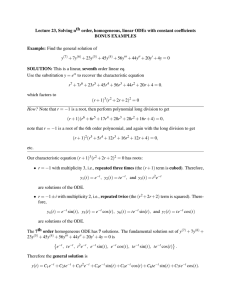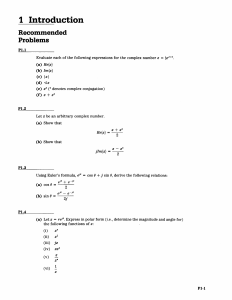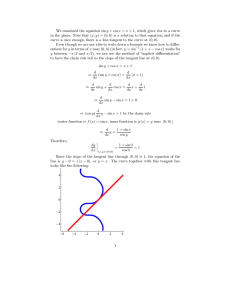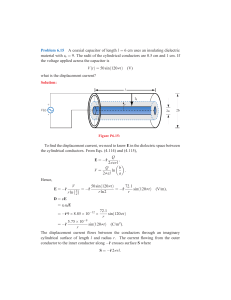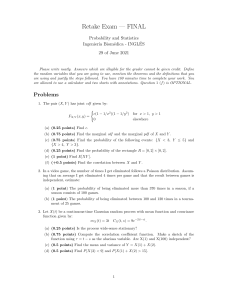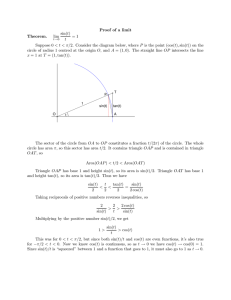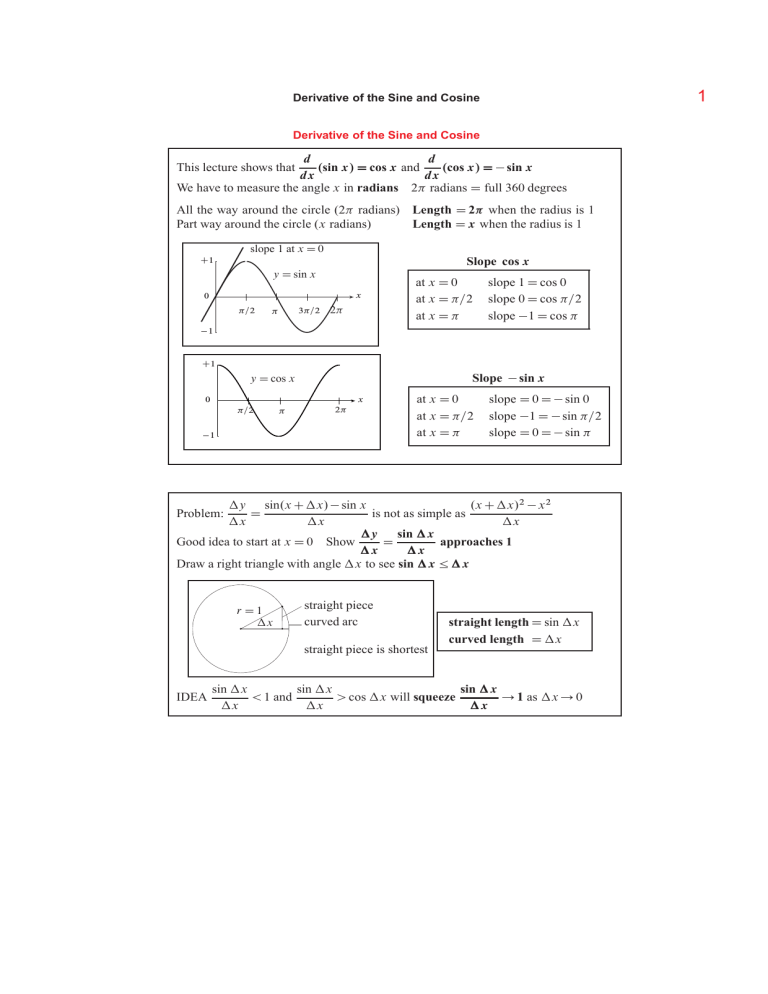
1 Derivative of the Sine and Cosine Derivative of the Sine and Cosine d d .sin x/ D cos x and .cos x/ D � sin x dx dx We have to measure the angle x in radians 2 radians D full 360 degrees This lecture shows that All the way around the circle (2 radians) Length D 2 when the radius is 1 Part way around the circle (x radians) Length D x when the radius is 1 slope 1 at x D 0 Slope cos x C1 y D sin x x 0 =2 3=2 2 �1 at x D 0 at x D =2 at x D C1 Slope � sin x y D cos x x 0 =2 slope 1 D cos 0 slope 0 D cos =2 slope �1 D cos 2 �1 at x D 0 at x D =2 at x D slope D 0 D � sin 0 slope �1 D � sin =2 slope D 0 D � sin y sin.x C x/ � sin x .x C x/2 � x 2 D is not as simple as x x x y sin x Good idea to start at x D 0 Show D approaches 1 x x Draw a right triangle with angle x to see sin x � x Problem: r D1 x straight piece curved arc straight piece is shortest IDEA straight length D sin x curved length D x sin x sin x sin x � 1 and � cos x will squeeze � 1 as x � 0 x x x 2 Derivative of the Sine and Cosine To prove sin x � cos x which is tan x � x x Angle x x tan x Full angle 2 Go to a bigger triangle 1 Triangle area D .1/.tan x/ greater than 2 x 1 Circular area D (whole circle) D .x/ 2 2 The squeeze cos x � sin x sin x � 1 tells us that approaches 1 x x .sin x/2 .1 � cos x/ � 1 means .1 C cos x/ � x 2 x .x/ 1 � cos x � 0 Cosine curve has slope D 0 So x For the slope at other x remember a formula from trigonometry: sin.x C x/ D sin x cos x C cos x sin x We want y D sin.x C x/ � sin x Divide that by x sin x y cos x � 1 D .sin x/ C .cos x/ Now let x � 0 x x x dy In the limit D .sin x/.0/ C .cos x/.1/ D cos x D Derivative of sin x dx dy For y D cos x the formula for cos.x C x/ leads similarly to D � sin x dx Practice Questions 1. What is the slope of y D sin x at x D and at x D 2 ? 2. What is the slope of y D cos x at x D =2 and x D 3=2 ? 3. The slope of .sin x/2 is 2 sin x cos x: The slope of .cos x/2 is �2 cos x sin x: Combined, the slope of .sin x/2 C .cos x/2 is zero. Why is this true ? 4. What is the second derivative of y D sin x (derivative of the derivative) ? 5. At what angle x does y D sin x C cos x have zero slope ? Derivative of the Sine and Cosine 6. Here are amazing infinite series for sin x and cos x: e ix D cos x C i sin x sin x D x x3 x5 � C � ��� 5�4�3�2�1 1 3�2�1 cos x D 1 � x2 2�1 C x4 4�3�2�1 � ��� (odd powers of x) (even powers of x) 7. Take the derivative of the sine series to see the cosine series. 8. Take the derivative of the cosine series to see minus the sine series. 9. Those series tell us that for small angles sin x � x and cos x � 1 � 12 x 2 : With these approximations check that .sin x/2 C .cos x/2 is close to 1: 3 MIT OpenCourseWare http://ocw.mit.edu Resource: Highlights of Calculus Gilbert Strang The following may not correspond to a particular course on MIT OpenCourseWare, but has been provided by the author as an individual learning resource. For information about citing these materials or our Terms of Use, visit: http://ocw.mit.edu/terms.
